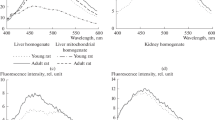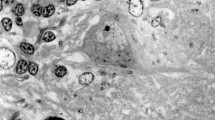Summary
The purpose of the present study was to clarify morphological differences in lipofuscin or so-called age pigments observed in the spiral ganglion cells of both young and adult rat groups and to characterize the size and structure of ceroid pigment granules generated in vitamin-E-deficient rats. The results showed different patterns of lipofuscin distribution in the two groups. The adult rat group had large aggregated lipoid, dark pigment granules of irregular shape in the cytoplasm. In contrast, the young group had small numbers of small, dense homogeneous granules, suggesting higher Schwann cell phagocytic activity. The ceroid pigments apparently included numerous vesicles and droplets of more variable density and size than the lipofuscin pigments appearing in the non-treated older animals. Both lipofuscin and ceroid pigments developing in such non-dividing cells are produced as a result of peroxidation reactions, so that the more they accumulate in the cytoplasm the more likely cell function deteriorates. The present study has shown that lipofuscin/ceroid granules are generated in the spiral ganglions under either endogenous (aging) or exogenous (vitamin E deficiency) conditions.
Similar content being viewed by others
References
Csallany AS, Ayaz KL, Su LC (1977) Effect of dietary vitamin E and aging on tissue lipofuscin pigment concentration in mice. J Nutr 107:1792–1799
El-Ghazzawi EF, Malaty HA (1975) Electron microscopic observations on extraneural lipofuscin in the monkey brain. Cell Tissue Res 161:555–565
Glees P, Hasan M (1976) Lipofuscin in neuronal aging and diseases. In: Bargmann W, Doerr W (eds) Normal and pathological anatomy, vol 32. Thieme, Stuttgart, pp 1–61
Harman D (1956) Aging, a theory based on free radical and radiation chemistry. J Gerontol 11:298–300
Hirai S, Yoshikawa M (1970) Vitamin E and aging of the nervous system. Proceedings of the 4th International Symposium on Vitamin E, Hakone, Japan. Kyoritsu, Tokyo, pp 228–237
Ishii T (1977) The fine structure of lipofuscin in the human inner ear. Arch Otorhinolaryngol 215:213–222
Ishii T, Murakami Y, Kimura RS, Balogh K Jr (1967) Electron microscopic and histochemical identification of lipofuscin in the human inner ear. Acta Otolaryngol (Stockh) 64:17–29
Nandy K (1978) Centrophenoxine effects on aging mammalian brain. J Am Geriatr Soc 26:74–81
Nandy K, Bourne GH (1966) Effect of centrophenoxine on the lipofuscin pigments in the neurons of senile guinea-pigs. Nature 210:313–314
Rosenbluth J (1962) The fine structure of acoustic ganglia in the rat. J Cell Biol 12:329–359
Rosenbluth J, Palay SL (1961) The fine structure of nerve cell bodies and their myelin sheaths in the eighth nerve ganglion of the goldfish. J Biophys Biochem Cytol 9:853–877
Samorajski T, Ordy JM, Keefe JR (1965) The fine structure of lipofuscin age pigment in the nervous system of aged mice. J Cell Biol 26:779–795
Samorajski T, Ordy JM, Randy-Reimer P (1968) Lipofuscin pigment accumulation in the nervous system of aging mice. Anat Rec 160:555–574
Spoendlin H (1972) Innervation densities of the cochlea. Acta Otolaryngol (Stockh) 73:235–248
Spoerri PE, Glees P (1973) Neuronal aging in cultures, an electron microscopic study. Exp Gerontol 8:259–263
Spoerri PE, Glees P, Ghazzawi EE (1974) Accumulation of lipofuscin in the myocardium of senile guinea pigs: dissolution and removal of lipofuscin following demethylaminoethyl pchlorophenoxyacetate administration. An electron microscopic study. Mech Ageing Dev 3:311–321
Sulkin NM, Srivanij P (1960) The experimental production of senile pigments in the nerve cells of young rats. J Gerontol 15:2–9
Tappel AL (1970) Biological antioxidant protection against lipid peroxidation damage. Am J Clin Nutr 23:1137–1139
Tappel AL, Fletcher B, Deamer D (1973) Effect of antioxidants and nutrients on lipid peroxidation fluorescent products and aging parameters in the mouse. J Gerontol 28:415–424
Author information
Authors and Affiliations
Rights and permissions
About this article
Cite this article
Igarashil, Y., Ishii, T. Lipofuscin pigments in the spiral ganglion of the rat. Eur Arch Otorhinolaryngol 247, 189–193 (1990). https://doi.org/10.1007/BF00175975
Received:
Accepted:
Issue Date:
DOI: https://doi.org/10.1007/BF00175975




